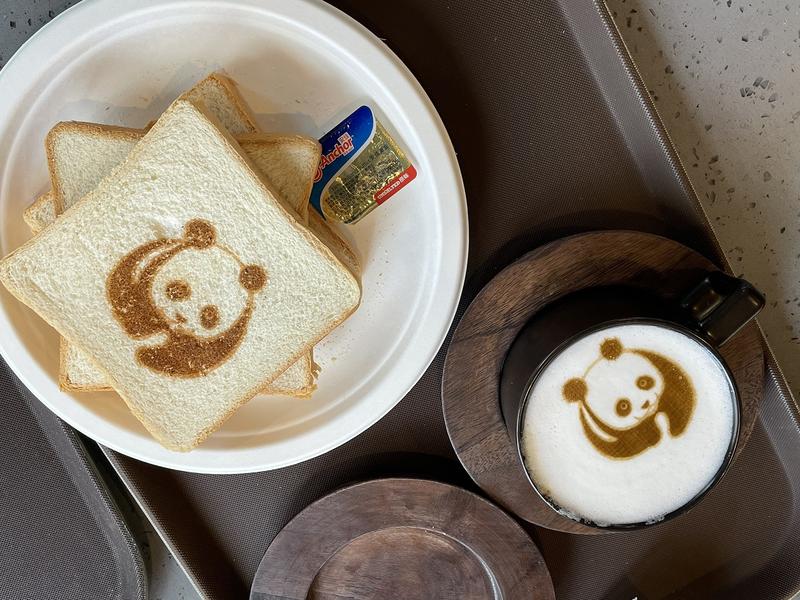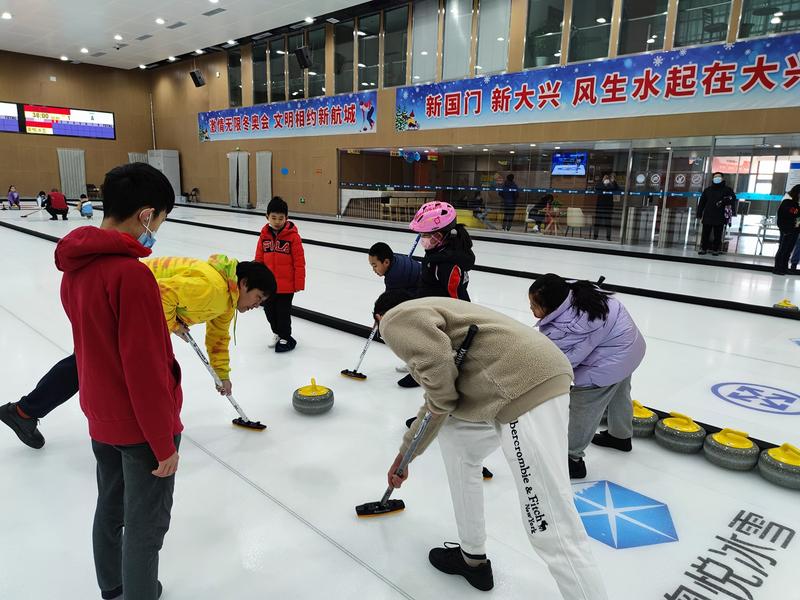Take inspiration from some of the capital's delights to explore the numerous attractions close to home, Xu Lin reports.
 At Beijing Zoo's Panda Coffee, visitors can sip a cup bedecked with a latte-art panda and sample toast stenciled with the image of the bear. (XU LIN / CHINA DAILY)
At Beijing Zoo's Panda Coffee, visitors can sip a cup bedecked with a latte-art panda and sample toast stenciled with the image of the bear. (XU LIN / CHINA DAILY)
Spring has arrived. Flowers are blooming. Birds are singing. It's the perfect time for an outing. And since travel plans are on hold due to the novel coronavirus popping up in various places, the holiday is an opportunity to appreciate the beauty of local surroundings and explore places nearby.
If you feel at a loss about what to do over the holidays, you can try to come up with some activities to your liking based on the following suggestions that take Beijing as an example: There is the zoo, aquarium, a diverse choice of parks and imperial gardens, and various sports to enjoy.
 The Beijing Aquarium showcases Chinese sturgeon, or zhonghuaxun, a "living fossil" that dates back to prehistoric times and lives mainly in the Yangtze River. (XU LIN / CHINA DAILY)
The Beijing Aquarium showcases Chinese sturgeon, or zhonghuaxun, a "living fossil" that dates back to prehistoric times and lives mainly in the Yangtze River. (XU LIN / CHINA DAILY)
Animal magic
Those who have seen the BBC documentary The Blue Planet will have been captivated by the beautiful scenes of the underwater world and its mysterious habitants.
However, even if you're skillful enough to dive into the depths of the ocean, it's subject to luck that whether you will encounter these intriguing denizens of the deep.
For city dwellers, the easiest way to see such marine marvels is to visit the local aquarium.
It's a place where you can not only find the colorful clown anemonefish, which was the star of the Hollywood blockbuster Finding Nemo, but other characterful sea dwellers.
The celebrity of the Beijing Aquarium is Houfu, a wild Chinese sturgeon that was moved there in 2015 after it was injured and saved.
Houfu is 3.6 meters long and weighs 280 kilograms. With its distinctive white belly, it swims like a queen accompanied by her courtiers, as more than 20 Chinese sturgeons surround her. These are all her close relations as they are her artificially bred children and grandchildren.
Ranked as a critically endangered species by the International Union for Conservation of Nature, Chinese sturgeon, or zhonghuaxun, is a "living fossil" that dates back to prehistoric times and lives mainly in the Yangtze River.
Besides sharks, penguins, manta rays, jellyfishes and corals, the aquarium also offers simple science popularization courses on-site free of charge to introduce the species of marine animals and promote the importance of biodiversity and marine environment protection.
 A leisurely cruise up Beijing's Changhe River passes by city landmarks, such as Purple Bamboo Park. (XU LIN / CHINA DAILY)
A leisurely cruise up Beijing's Changhe River passes by city landmarks, such as Purple Bamboo Park. (XU LIN / CHINA DAILY)
Visitors can refer to the aquarium's official WeChat account for the latest schedule of courses.
Most participants are preschool children and primary school students. They like the question-and-answer and interactive sessions.
"Such courses can inspire children to think about how to do something that is within their capabilities to protect biodiversity and the environment," says Cheng Ran, who's in charge of the aquarium's science popularization courses.
Children can observe the specific marine animals closely in front of the giant tank while taking the courses. They can also watch photos and short videos filmed at the aquarium, showing interesting and unknown scenes that are otherwise rarely seen by visitors.
The aquarium also invites experts from various fields such as breeding and aquarium landscaping to share their professional knowledge via livestreams.
As the Beijing Aquarium is located inside the Beijing Zoo, you can simply buy a joint ticket to visit both venues on the same day, which means you can also have close encounters with a wide variety of mammals, amphibians, reptiles and birds. The popular animals include giant pandas, alpacas, giraffes, polar bears and penguins.
Visitors are reminded that feeding animals is prohibited in the zoo except in approved areas, because there are scientifically formulated diets to ensure their health and well-being.
Staff members and public-spirited volunteers are on hand, not only to dissuade visitors from feeding the animals, but also to promote scientific knowledge about the animals. If you're curious about an animal, ask them a question.
The national craze for Bing Dwen Dwen, the mascot of the 2022 Beijing Winter Olympic Games, has proved again Chinese people's love for its national treasure, the giant pandas.
At the zoo's Panda Coffee, visitors can sip a cup of coffee bedecked with a latte-art panda and sample toast stenciled with the image of a panda. Since the panda is the theme of the cafe, it is decorated accordingly, and it has become a must-visit place for those who love the black and white bundles of joy.
 A panda greets visitors to the coffee shop. (XU LIN / CHINA DAILY)
A panda greets visitors to the coffee shop. (XU LIN / CHINA DAILY)
Experience the royal getaway
From the dock of the zoo, you can hop on a traditional-style boat for a leisurely one-hour cruise up the Changhe River to the Summer Palace.
The 9-kilometer-long waterway passes by the city's landmarks such as Purple Bamboo Park, or Zizhuyuan, and Wanshou Temple. The cruises operate between April and October.
The imperial families of the Qing Dynasty (1644-1911) used to take such boats along the river, which was then exclusively for their use, to their imperial abodes in the suburb.
The Empress Dowager Cixi (1835-1908) made the same journey along the willow tree-lined Changhe River every summer to escape the city-center heat.
The river is also an important section of the 3,200-kilometer-long Grand Canal connecting Beijing and Hangzhou in East China's Zhejiang province, the longest artificial waterway in the world.
Today, the voyage allows ordinary people to enjoy rights and privileges of the rulers in the feudal society.
Spring is a good time to visit the Summer Palace, and you can extend your time on the water by taking a boat on Kunming Lake to enjoy the breeze and charming scenes of the imperial garden.
Young Chinese like to have an elegant afternoon tea on the electrical boat, with coffee or tea, pastries and fruits in lunchboxes that they carefully prepare in advance.
Then comes the inevitable ritual for hipsters of the internet era-taking a pretty selfie, retouching it and posting it on social media.
Before sunset, photographers who train their lens on things other than themselves will want to secure their spot on the bank to shoot photos of the marble 17-arch bridge under the sunset's glow.
Today, the royal park, like any park in the city, is among the best places to observe how ordinary residents enjoy their leisure time.
Especially the elderly, they will get up early to exercise, sing songs and socialize. The Summer Palace is no exception, and elderly visitors will be standing with their year cards in their hands ready to enter the Summer Palace when it opens at 6 am.
You can see such energetic older people in many Chinese parks.
Sitting in a pavilion, they take turns to sing old songs that remind them of their youth, or sing in chorus. The background music is often provided by an electronic keyboard or accordion player, with a portable stereo set.
 Curling enthusiasts enjoy the game in Beijing. (XU LIN / CHINA DAILY)
Curling enthusiasts enjoy the game in Beijing. (XU LIN / CHINA DAILY)
Shifting stones on ice
Losing weight and keeping fit are popular pursuits in spring, as people want to prepare to look their best during the summer, when they won't be bundled up in clothes.
It's like an annual cycle-after losing weight in spring, and staying as slim as you can for summer, you indulge in hearty meals at the start of autumn. Starting from the first solar term of autumn, liqiu, or Beginning of Autumn, in early August, Chinese people have an annual culinary ritual called tieqiubiao, which involves eating more meat in preparation for the cold weather of winter.
In spring, outdoor activities and ballgames are popular ways to shed some calories and keep fit.
While the sunnier days will lure many outside, the 2022 Winter Olympics have stirred many people's interest in ice and snow sports. Indoor ice rinks and ski resorts allow you to enjoy the excitement and improve your skills all year around.
One of the sports that caught many people's attention during the Games was curling. But only after you've played it can you truly appreciate it.
It's like playing chess on ice-you have to choose the best options, making the best use of your stones and brooms. The aim is to place as many stones near the center of the target as you can, and, if you are playing competitively, trying to stop your opponents from doing the same.
The situation undergoes rapid changes as stones are slid into position or are employed to knock out or block the other team's stones.
Olympjoy International Curling Club is one of the few curling clubs open to the general public.
Besides hosting national and international curling competitions, the club is also a training center for student players from primary and middle schools and professional athletes.
"Thanks to the Games, our bookings early this year were almost full. I'm confident about the market because more ordinary Chinese have become interested in curling over the past two years," says Wang Dequan, marketing director of the club.
He says many have been tempted to try after watching the Games, and then fall in love with curling after playing it and learning more about the spirit of the sport.
He explains that in a standard match each curling rink has eight players, but for amateurs, the number can be about 10 to 16. A coach of the club teaches basic skills and strategies and acts as a referee.
It's suitable for a gathering of friends or several families. Many corporations also choose the club for team building.
"Teamwork counts in curling. It exercises both brain and body. Once the opponent slides a stone, you have to deal with emergency and think about your next move."
If you go
Please check the COVID-19 control and prevention policy of the scenic area and make a reservation in advance before travel.
Contact the writer at xulin@chinadaily.com.cn


